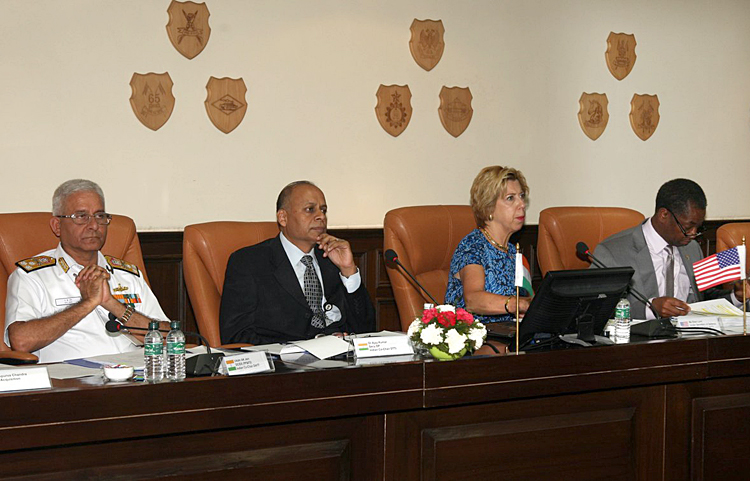INDIAN ARMED FORCES CHIEFS ON
OUR RELENTLESS AND FOCUSED PUBLISHING EFFORTS

SP Guide Publications puts forth a well compiled articulation of issues, pursuits and accomplishments of the Indian Army, over the years

I am confident that SP Guide Publications would continue to inform, inspire and influence.

My compliments to SP Guide Publications for informative and credible reportage on contemporary aerospace issues over the past six decades.
DTTI and futuristic weapons
 |
By Lt. General P.C. Katoch (Retd) Former Director General of Information Systems, Indian Army |

The 7th Defence Technology and Trade Initiative (DTTI) meeting was held in New Delhi on 18 July 2018, co-chaired by, Ajay Kumar, Secretary Defence Production and US Under Secretary of Defence for Acquisition and Sustainment Ellen M Lord. In 2012, US Secretary of Defence Leon Panetta directed Deputy Secretary of Defence Ashton Carter to undertake an initiative to provide increased US senior level oversight and engagement to India, getting beyond obstacles. The undertaking is referred to as the Defense Technology and Trade Initiative (DTTI). The aim of DTTI is to bring sustained leadership focus to the bilateral defence trade relationship and create opportunities for co-production and co-development of defence equipment. A number of Joint Working Groups spanning varied projects have been established under DTTI on both sides, which have identified various projects for the Armed Forces. The Working Groups meet regularly to discuss and take forward the projects. The fact that the US has declared India as a major defence partner under the National Defence Authorization Act in 2017 has given an impetus to the DTTI. At the 7th DTTI meeting it was reiterated that the India-US defence cooperation is one of the core pillars of the defence relationship between the two countries. The Indian side conveyed that a large defence outlay is planned for India's defence requirements in the future and the contribution of the defence industry in partnership with foreign manufacturers is expected to be significant. Ellen Lord said "US has designated India as a 'Major Defence Partner' and expected the defence relationship between the two countries to be further strengthened".
She also added that the DTTI was an important forum leading to the 2+2 dialogue between the two countries. The Indian side said different joint working groups under the DTTI had made considerable progress, adding, "On the land systems front and on projects under the DRDO, both sides have identified projects where scope of co-production/co-development of systems exists". Both countries are looking to support more expansive defence industrial collaboration by formalizing a set of procedures for engagement and a protocol for facilitating secure transfers of technologies (ToT). Procedures for mutual engagement are to be formalized through a proposed standard operating procedure (SOP), understood to be a requirement to enable DTTI better respond to Indian technology demands in line with US military export licensing processes – this would expand areas of defence industrial collaboration. Security of technologies are to be addressed through introducing "industrial security annexure" to be added to the DTTI set of guidelines. The security annex is considered necessary to respond to a US requirement for enhanced control of the military technologies it transfers to India. The two countries' existing technology control mechanism was introduced in 2002 and is known as the General Security Measures for Protection of Classified Military Information (GSOMIA). Already among the top arms supplier to India with sales worth $15 billion over the decade, the US remains eager to grab more lucrative defence deals and joint co-development projects in the lucrative India market. Hitherto-fore, projects proposed by the US under DTTI were elementary in nature albeit India looking for transformative and futuristic military technologies to not only bridge the asymmetry with rivals but try and outpace them. But this did not receive adequate response from the US side.
However, of late US has offered India trilateral venture with Israel to develop futuristic infantry combat vehicle (FICV), as well as participation in its future vertical-lift (FVL) aircraft program for five different helicopters under the DTTI. MoD has also said that the Indian Navy and US Navy are "constructively engaged" in their joint working group to explore aircraft carrier technologies, and that land systems projects have also been identified "where the scope of co-production/co-development of systems exists". However, considering that DTTI was formed in 2012 and formal meetings and JWGs have been in progress, in the overall context the progress and even the abovementioned areas of collaboration indicates the approach and progress is patchy. Whether this is because of lack of initiative and enthusiasm from the India side is difficult to assess. However, if US considers India major defence partner and actually sees India as a counterweight to China-dominated Asia, with consequent geostrategic ramifications in the IOR, then the DTTI needs to adopt a holistic approach. 21st Century warfare would see extensive play of cyber weapons, heat-rays and lasers, drones and anti-drone systems, stealth and hypersonic platforms and weapon systems, precision guided munitions multi-domain sensor systems, battlefield management software technologies, space combat and the like. The usual cliché 'who will share latest technology' notwithstanding, these areas need to be included in the DTTI ambit, as also with India's other strategic partners. Besides, the US has now placed eased export controls for high-technology product sales to India by designating it as a Strategic Trade Authorization-1 (STA-1) country, the only South Asian nation to be on the list; allowing India to buy more advanced and sensitive technologies from America at par with that of the U.S.' closest allies. India, therefore, should go full hog.





